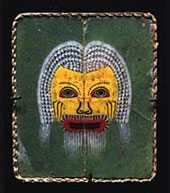 During the 1st century BC-1st century AD in Ptolemaic Egypt there were created extraordinary canes of glass that contained within (running their length) highly detailed figurative imagery in the manner of the murrine (millifiore) canes made today. Among this type of figurative mosaic glass cane work were half-images, which, when two slices were removed from a single cane and laid side by side, formed the representation of what are thought to be grotesque masks used by the actors of ancient Greek and Roman theater. Contemporary with these intricate canes, there were also produced beads with applied face cane slices. More elementary in design and execution than the mask representations, these faces were equally rare and unique. During the 1st century BC-1st century AD in Ptolemaic Egypt there were created extraordinary canes of glass that contained within (running their length) highly detailed figurative imagery in the manner of the murrine (millifiore) canes made today. Among this type of figurative mosaic glass cane work were half-images, which, when two slices were removed from a single cane and laid side by side, formed the representation of what are thought to be grotesque masks used by the actors of ancient Greek and Roman theater. Contemporary with these intricate canes, there were also produced beads with applied face cane slices. More elementary in design and execution than the mask representations, these faces were equally rare and unique.
|
|---|



